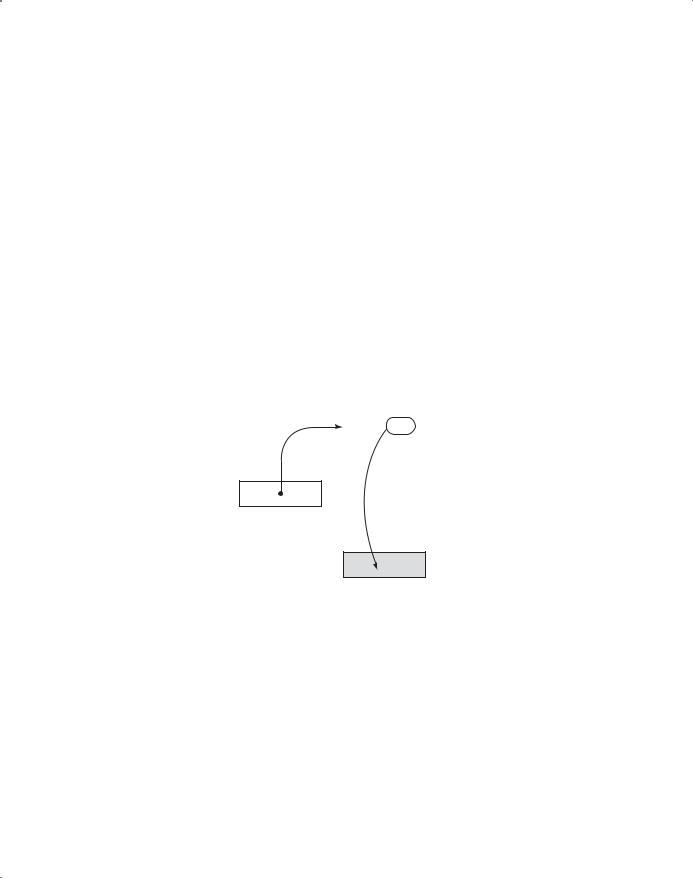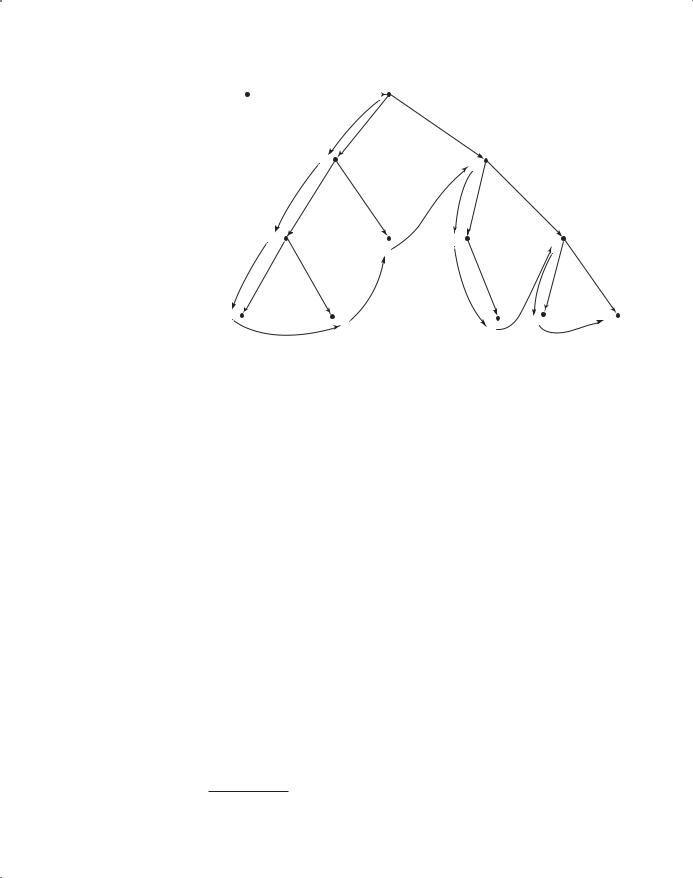
- •New to the Tenth Edition
- •Preface
- •Acknowledgments
- •About the Author
- •Contents
- •1.1 Reasons for Studying Concepts of Programming Languages
- •1.2 Programming Domains
- •1.3 Language Evaluation Criteria
- •1.4 Influences on Language Design
- •1.5 Language Categories
- •1.6 Language Design Trade-Offs
- •1.7 Implementation Methods
- •1.8 Programming Environments
- •Summary
- •Problem Set
- •2.1 Zuse’s Plankalkül
- •2.2 Pseudocodes
- •2.3 The IBM 704 and Fortran
- •2.4 Functional Programming: LISP
- •2.5 The First Step Toward Sophistication: ALGOL 60
- •2.6 Computerizing Business Records: COBOL
- •2.7 The Beginnings of Timesharing: BASIC
- •2.8 Everything for Everybody: PL/I
- •2.9 Two Early Dynamic Languages: APL and SNOBOL
- •2.10 The Beginnings of Data Abstraction: SIMULA 67
- •2.11 Orthogonal Design: ALGOL 68
- •2.12 Some Early Descendants of the ALGOLs
- •2.13 Programming Based on Logic: Prolog
- •2.14 History’s Largest Design Effort: Ada
- •2.15 Object-Oriented Programming: Smalltalk
- •2.16 Combining Imperative and Object-Oriented Features: C++
- •2.17 An Imperative-Based Object-Oriented Language: Java
- •2.18 Scripting Languages
- •2.19 The Flagship .NET Language: C#
- •2.20 Markup/Programming Hybrid Languages
- •Review Questions
- •Problem Set
- •Programming Exercises
- •3.1 Introduction
- •3.2 The General Problem of Describing Syntax
- •3.3 Formal Methods of Describing Syntax
- •3.4 Attribute Grammars
- •3.5 Describing the Meanings of Programs: Dynamic Semantics
- •Bibliographic Notes
- •Problem Set
- •4.1 Introduction
- •4.2 Lexical Analysis
- •4.3 The Parsing Problem
- •4.4 Recursive-Descent Parsing
- •4.5 Bottom-Up Parsing
- •Summary
- •Review Questions
- •Programming Exercises
- •5.1 Introduction
- •5.2 Names
- •5.3 Variables
- •5.4 The Concept of Binding
- •5.5 Scope
- •5.6 Scope and Lifetime
- •5.7 Referencing Environments
- •5.8 Named Constants
- •Review Questions
- •6.1 Introduction
- •6.2 Primitive Data Types
- •6.3 Character String Types
- •6.4 User-Defined Ordinal Types
- •6.5 Array Types
- •6.6 Associative Arrays
- •6.7 Record Types
- •6.8 Tuple Types
- •6.9 List Types
- •6.10 Union Types
- •6.11 Pointer and Reference Types
- •6.12 Type Checking
- •6.13 Strong Typing
- •6.14 Type Equivalence
- •6.15 Theory and Data Types
- •Bibliographic Notes
- •Programming Exercises
- •7.1 Introduction
- •7.2 Arithmetic Expressions
- •7.3 Overloaded Operators
- •7.4 Type Conversions
- •7.5 Relational and Boolean Expressions
- •7.6 Short-Circuit Evaluation
- •7.7 Assignment Statements
- •7.8 Mixed-Mode Assignment
- •Summary
- •Problem Set
- •Programming Exercises
- •8.1 Introduction
- •8.2 Selection Statements
- •8.3 Iterative Statements
- •8.4 Unconditional Branching
- •8.5 Guarded Commands
- •8.6 Conclusions
- •Programming Exercises
- •9.1 Introduction
- •9.2 Fundamentals of Subprograms
- •9.3 Design Issues for Subprograms
- •9.4 Local Referencing Environments
- •9.5 Parameter-Passing Methods
- •9.6 Parameters That Are Subprograms
- •9.7 Calling Subprograms Indirectly
- •9.8 Overloaded Subprograms
- •9.9 Generic Subprograms
- •9.10 Design Issues for Functions
- •9.11 User-Defined Overloaded Operators
- •9.12 Closures
- •9.13 Coroutines
- •Summary
- •Programming Exercises
- •10.1 The General Semantics of Calls and Returns
- •10.2 Implementing “Simple” Subprograms
- •10.3 Implementing Subprograms with Stack-Dynamic Local Variables
- •10.4 Nested Subprograms
- •10.5 Blocks
- •10.6 Implementing Dynamic Scoping
- •Problem Set
- •Programming Exercises
- •11.1 The Concept of Abstraction
- •11.2 Introduction to Data Abstraction
- •11.3 Design Issues for Abstract Data Types
- •11.4 Language Examples
- •11.5 Parameterized Abstract Data Types
- •11.6 Encapsulation Constructs
- •11.7 Naming Encapsulations
- •Summary
- •Review Questions
- •Programming Exercises
- •12.1 Introduction
- •12.2 Object-Oriented Programming
- •12.3 Design Issues for Object-Oriented Languages
- •12.4 Support for Object-Oriented Programming in Smalltalk
- •12.5 Support for Object-Oriented Programming in C++
- •12.6 Support for Object-Oriented Programming in Objective-C
- •12.7 Support for Object-Oriented Programming in Java
- •12.8 Support for Object-Oriented Programming in C#
- •12.9 Support for Object-Oriented Programming in Ada 95
- •12.10 Support for Object-Oriented Programming in Ruby
- •12.11 Implementation of Object-Oriented Constructs
- •Summary
- •Programming Exercises
- •13.1 Introduction
- •13.2 Introduction to Subprogram-Level Concurrency
- •13.3 Semaphores
- •13.4 Monitors
- •13.5 Message Passing
- •13.6 Ada Support for Concurrency
- •13.7 Java Threads
- •13.8 C# Threads
- •13.9 Concurrency in Functional Languages
- •13.10 Statement-Level Concurrency
- •Summary
- •Review Questions
- •Problem Set
- •14.1 Introduction to Exception Handling
- •14.2 Exception Handling in Ada
- •14.3 Exception Handling in C++
- •14.4 Exception Handling in Java
- •14.5 Introduction to Event Handling
- •14.6 Event Handling with Java
- •14.7 Event Handling in C#
- •Review Questions
- •Problem Set
- •15.1 Introduction
- •15.2 Mathematical Functions
- •15.3 Fundamentals of Functional Programming Languages
- •15.4 The First Functional Programming Language: LISP
- •15.5 An Introduction to Scheme
- •15.6 Common LISP
- •15.8 Haskell
- •15.10 Support for Functional Programming in Primarily Imperative Languages
- •15.11 A Comparison of Functional and Imperative Languages
- •Review Questions
- •Problem Set
- •16.1 Introduction
- •16.2 A Brief Introduction to Predicate Calculus
- •16.3 Predicate Calculus and Proving Theorems
- •16.4 An Overview of Logic Programming
- •16.5 The Origins of Prolog
- •16.6 The Basic Elements of Prolog
- •16.7 Deficiencies of Prolog
- •16.8 Applications of Logic Programming
- •Review Questions
- •Programming Exercises
- •Bibliography
- •Index

6.11 Pointer and Reference Types |
289 |
6.10.6Implementation of Union Types
Unions are implemented by simply using the same address for every possible variant. Sufficient storage for the largest variant is allocated. The tag of a discriminated union is stored with the variant in a recordlike structure.
At compile time, the complete description of each variant must be stored. This can be done by associating a case table with the tag entry in the descriptor. The case table has an entry for each variant, which points to a descriptor for that particular variant. To illustrate this arrangement, consider the following Ada example:
type Node (Tag : Boolean) is
record
case Tag is
when True => Count : Integer; when False => Sum : Float;
end case; end record;
The descriptor for this type could have the form shown in Figure 6.9.
Figure 6.9 |
|
Discriminated union |
|
|
|
|
|
|
|
|
|
|
A compile-time |
Tag |
BOOLEAN |
|
|
|
|
|
|
|
|
|
|
descriptor for a |
|
|
|
|
|
|
|
|
|
|||
|
|
|
|
|
|
|
|
|
|
|
|
|
discriminated union |
|
Offset |
|
|
|
|
|
|
|
|
Name |
|
|
|
|
|
|
|
|
|
Count |
||||
|
|
|
|
|
|
|
|
|
||||
|
|
|
|
|
|
Case table |
|
|
Integer |
Type |
||
|
|
|
|
|
|
|||||||
|
|
|
|
|
|
True |
|
|
|
|
||
|
|
Address |
|
|
|
|
|
|
|
|
||
|
|
|
|
|
|
|
|
|
|
|
||
|
|
|
|
False |
|
|
|
|
|
|
||
|
|
|
|
|
|
|
|
|
|
Sum |
Name |
|
|
|
|
|
|
|
|
|
|
|
|||
|
|
|
|
|
|
|
|
|
|
|
||
|
|
|
|
|
|
|
|
|
|
|
Float |
Type |
|
|
|
|
|
|
|
|
|
|
|
|
|
6.11 Pointer and Reference Types
A pointer type is one in which the variables have a range of values that consists of memory addresses and a special value, nil. The value nil is not a valid address and is used to indicate that a pointer cannot currently be used to reference a memory cell.
Pointers are designed for two distinct kinds of uses. First, pointers provide some of the power of indirect addressing, which is frequently used in assembly language programming. Second, pointers provide a way to manage dynamic storage. A pointer can be used to access a location in an area where storage is dynamically allocated called a heap.

290 |
Chapter 6 Data Types |
Variables that are dynamically allocated from the heap are called heap- dynamic variables. They often do not have identifiers associated with them and thus can be referenced only by pointer or reference type variables. Variables without names are called anonymous variables. It is in this latter application area of pointers that the most important design issues arise.
Pointers, unlike arrays and records, are not structured types, although they are defined using a type operator (* in C and C++ and access in Ada). Furthermore, they are also different from scalar variables because they are used to reference some other variable, rather than being used to store data. These two categories of variables are called reference types and value types, respectively.
Both kinds of uses of pointers add writability to a language. For example, suppose it is necessary to implement a dynamic structure like a binary tree in a language like Fortran 77, which does not have pointers. This would require the programmer to provide and maintain a pool of available tree nodes, which would probably be implemented in parallel arrays. Also, because of the lack of dynamic storage in Fortran 77, it would be necessary for the programmer to guess the maximum number of required nodes. This is clearly an awkward and error-prone way to deal with binary trees.
Reference variables, which are discussed in Section 6.11.6, are closely related to pointers.
6.11.1Design Issues
The primary design issues particular to pointers are the following:
•What are the scope and lifetime of a pointer variable?
•What is the lifetime of a heap-dynamic variable (the value a pointer references)?
•Are pointers restricted as to the type of value to which they can point?
•Are pointers used for dynamic storage management, indirect addressing, or both?
•Should the language support pointer types, reference types, or both?
6.11.2Pointer Operations
Languages that provide a pointer type usually include two fundamental pointer operations: assignment and dereferencing. The first operation sets a pointer variable’s value to some useful address. If pointer variables are used only to manage dynamic storage, then the allocation mechanism, whether by operator or built-in subprogram, serves to initialize the pointer variable. If pointers are used for indirect addressing to variables that are not heap dynamic, then there must be an explicit operator or built-in subprogram for fetching the address of a variable, which can then be assigned to the pointer variable.
An occurrence of a pointer variable in an expression can be interpreted in two distinct ways. First, it could be interpreted as a reference to the contents

6.11 Pointer and Reference Types |
291 |
of the memory cell to which it is bound, which in the case of a pointer is an address. This is exactly how a nonpointer variable in an expression would be interpreted, although in that case its value likely would not be an address. However, the pointer could also be interpreted as a reference to the value in the memory cell pointed to by the memory cell to which the pointer variable is bound. In this case, the pointer is interpreted as an indirect reference. The former case is a normal pointer reference; the latter is the result of dereferencing the pointer. Dereferencing, which takes a reference through one level of indirection, is the second fundamental pointer operation.
Dereferencing of pointers can be either explicit or implicit. In Fortran 95+ it is implicit, but in many other contemporary languages, it occurs only when explicitly specified. In C++, it is explicitly specified with the asterisk (*) as a prefix unary operator. Consider the following example of dereferencing: If ptr is a pointer variable with the value 7080 and the cell whose address is 7080 has the value 206, then the assignment
j = *ptr
sets j to 206. This process is shown in Figure 6.10.
Figure 6.10 |
7080 |
|
|||
|
|
|
|
206 |
An anonymous |
The assignment |
|
|
|||
|
|
dynamic variable |
|||
|
|
|
|||
operation j = *ptr |
|
|
|
|
|
|
ptr |
|
|
|
|
|
7080 |
|
|
|
|
|
|
|
|
|
|
j
When pointers point to records, the syntax of the references to the fields of these records varies among languages. In C and C++, there are two ways a pointer to a record can be used to reference a field in that record. If a pointer variable p points to a record with a field named age, (*p).age can be used to refer to that field. The operator ->, when used between a pointer to a record and a field of that record, combines dereferencing and field reference. For example, the expression p -> age is equivalent to (*p).age. In Ada, p.age can be used, because such uses of pointers are implicitly dereferenced.
Languages that provide pointers for the management of a heap must include an explicit allocation operation. Allocation is sometimes specified with a subprogram, such as malloc in C. In languages that support object-oriented programming, allocation of heap objects is often specified with the new operator. C++, which does not provide implicit deallocation, uses delete as its deallocation operator.

292 |
Chapter 6 Data Types |
6.11.3Pointer Problems
The first high-level programming language to include pointer variables was PL/I, in which pointers could be used to refer to both heap-dynamic variables and other program variables. The pointers of PL/I were highly flexible, but their use could lead to several kinds of programming errors. Some of the problems of PL/I pointers are also present in the pointers of subsequent languages. Some recent languages, such as Java, have replaced pointers completely with reference types, which, along with implicit deallocation, minimize the primary problems with pointers. A reference type is really only a pointer with restricted operations.
6.11.3.1 Dangling Pointers
A dangling pointer, or dangling reference, is a pointer that contains the address of a heap-dynamic variable that has been deallocated. Dangling pointers are dangerous for several reasons. First, the location being pointed to may have been reallocated to some new heap-dynamic variable. If the new variable is not the same type as the old one, type checks of uses of the dangling pointer are invalid. Even if the new dynamic variable is the same type, its new value will have no relationship to the old pointer’s dereferenced value. Furthermore, if the dangling pointer is used to change the heap-dynamic variable, the value of the new heap-dynamic variable will be destroyed. Finally, it is possible that the location now is being temporarily used by the storage management system, possibly as a pointer in a chain of available blocks of storage, thereby allowing a change to the location to cause the storage manager to fail.
The following sequence of operations creates a dangling pointer in many languages:
1.A new heap-dynamic variable is created and pointer p1 is set to point at it.
2.Pointer p2 is assigned p1’s value.
3.The heap-dynamic variable pointed to by p1 is explicitly deallocated (possibly setting p1 to nil), but p2 is not changed by the operation. p2 is now a dangling pointer. If the deallocation operation did not change p1, both p1 and p2 would be dangling. (Of course, this is a problem of aliasing—p1 and p2 are aliases.)
For example, in C++ we could have the following:
int * arrayPtr1;
int * arrayPtr2 = new int[100]; arrayPtr1 = arrayPtr2;
delete [] arrayPtr2;
//Now, arrayPtr1 is dangling, because the heap storage
//to which it was pointing has been deallocated.

6.11 Pointer and Reference Types |
293 |
In C++, both arrayPtr1 and arrayPtr2 are now dangling pointers, because the C++ delete operator has no effect on the value of its operand pointer. In C++, it is common (and safe) to follow a delete operator with an assignment of zero, which represents null, to the pointer whose pointed-to value has been deallocated.
Notice that the explicit deallocation of dynamic variables is the cause of dangling pointers.
histor y note
Pascal included an explicit deallocate operator: dispose. Because of the problem of dangling pointers caused by dispose, some Pascal implementations simply ignored dispose when it appeared in a program. Although this effectively prevents dangling pointers, it also disallows the reuse of heap storage that the program no longer needs. Recall that Pascal initially was designed as a teaching language, rather than as an industrial tool.
6.11.3.2 Lost Heap-Dynamic Variables
A lost heap-dynamic variable is an allocated heap-dynamic variable that is no longer accessible to the user program. Such variables are often called garbage, because they are not useful for their original purpose, and they also cannot be reallocated for some new use in the program. Lost heap-dynamic variables are most often created by the following sequence of operations:
1.Pointer p1 is set to point to a newly created heap-dynamic variable.
2.p1 is later set to point to another newly created heap-dynamic variable.
The first heap-dynamic variable is now inaccessible, or lost. This is sometimes called memory leakage. Memory leakage is a problem, regardless of whether the language uses implicit or explicit deallocation. In the following sections, we investigate how language designers have dealt with the problems of dangling pointers and lost heap-dynamic variables.
6.11.4Pointers in Ada
Ada’s pointers are called access types. The dangling-pointer problem is partially alleviated by Ada’s design, at least in theory. A heap-dynamic variable may be (at the implementor’s option) implicitly deallocated at the end of the scope of its pointer type; thus, dramatically lessening the need for explicit deallocation. However, few if any Ada compilers implement this form of garbage collection, so the advantage is nearly always in theory only. Because heap-dynamic variables can be accessed by variables of only one type, when the end of the scope of that type declaration is reached, no pointers can be left pointing at the dynamic variable. This diminishes the problem, because improperly implemented explicit deallocation is the major source of dangling pointers. Unfortunately, the Ada language also has an explicit deallocator, Unchecked_Deallocation. Its name is meant to discourage its use, or at least warn the user of its potential problems. Unchecked_Deallocation can cause dangling pointers.
The lost heap-dynamic variable problem is not eliminated by Ada’s design of pointers.

294 |
Chapter 6 Data Types |
6.11.5Pointers in C and C++
In C and C++, pointers can be used in the same ways as addresses are used in assembly languages. This means they are extremely flexible but must be used with great care. This design offers no solutions to the dangling pointer or lost heap-dynamic variable problems. However, the fact that pointer arithmetic is possible in C and C++ makes their pointers more interesting than those of the other programming languages.
C and C++ pointers can point at any variable, regardless of where it is allocated. In fact, they can point anywhere in memory, whether there is a variable there or not, which is one of the dangers of such pointers.
In C and C++, the asterisk (*) denotes the dereferencing operation, and the ampersand (&) denotes the operator for producing the address of a variable. For example, consider the following code:
int *ptr;
int count, init;
...
ptr = &init; count = *ptr;
The assignment to the variable ptr sets it to the address of init. The assignment to count dereferences ptr to produce the value at init, which is then assigned to count. So, the effect of the two assignment statements is to assign the value of init to count. Notice that the declaration of a pointer specifies its domain type.
Notice that the two assignment statements above are equivalent in their effect on count to the single assignment
count = init;
Pointers can be assigned the address value of any variable of the correct domain type, or they can be assigned the constant zero, which is used for nil.
Pointer arithmetic is also possible in some restricted forms. For example, if ptr is a pointer variable that is declared to point at some variable of some data type, then
ptr + index
is a legal expression. The semantics of such an expression is as follows. Instead of simply adding the value of index to ptr, the value of index is first scaled by the size of the memory cell (in memory units) to which ptr is pointing (its base type). For example, if ptr points to a memory cell for a type that is four memory units in size, then index is multiplied by 4, and the result is added to ptr. The primary purpose of this sort of address arithmetic is array manipulation. The following discussion is related to singledimensioned arrays only.

6.11 Pointer and Reference Types |
295 |
In C and C++, all arrays use zero as the lower bound of their subscript ranges, and array names without subscripts always refer to the address of the first element. Consider the following declarations:
int list [10];
int *ptr;
Consider the assignment
ptr = list;
which assigns the address of list[0] to ptr, because an array name without a subscript is interpreted as the base address of the array. Given this assignment, the following are true:
•*(ptr + 1) is equivalent to list[1].
•*(ptr + index) is equivalent to list[index].
•ptr[index] is equivalent to list[index].
It is clear from these statements that the pointer operations include the same scaling that is used in indexing operations. Furthermore, pointers to arrays can be indexed as if they were array names.
Pointers in C and C++ can point to functions. This feature is used to pass functions as parameters to other functions. Pointers are also used for parameter passing, as discussed in Chapter 9.
C and C++ include pointers of type void *, which can point at values of any type. They are in effect generic pointers. However, type checking is not a problem with void * pointers, because these languages disallow dereferencing them. One common use of void * pointers is as the types of parameters of functions that operate on memory. For example, suppose we wanted a function to move a sequence of bytes of data from one place in memory to another. It would be most general if it could be passed two pointers of any type. This would be legal if the corresponding formal parameters in the function were void * type. The function could then convert them to char * type and do the operation, regardless of what type pointers were sent as actual parameters.
6.11.6Reference Types
A reference type variable is similar to a pointer, with one important and fundamental difference: A pointer refers to an address in memory, while a reference refers to an object or a value in memory. As a result, although it is natural to perform arithmetic on addresses, it is not sensible to do arithmetic on references.
C++ includes a special kind of reference type that is used primarily for the formal parameters in function definitions. A C++ reference type variable is a constant pointer that is always implicitly dereferenced. Because a C++ reference type variable is a constant, it must be initialized with the address of some

296 |
Chapter 6 Data Types |
variable in its definition, and after initialization a reference type variable can never be set to reference any other variable. The implicit dereference prevents assignment to the address value of a reference variable.
Reference type variables are specified in definitions by preceding their names with ampersands (&). For example,
int result = 0;
int &ref_result = result;
...
ref_result = 100;
In this code segment, result and ref_result are aliases.
When used as formal parameters in function definitions, C++ reference types provide for two-way communication between the caller function and the called function. This is not possible with nonpointer primitive parameter types, because C++ parameters are passed by value. Passing a pointer as a parameter accomplishes the same two-way communication, but pointer formal parameters require explicit dereferencing, making the code less readable and less safe. Reference parameters are referenced in the called function exactly as are other parameters. The calling function need not specify that a parameter whose corresponding formal parameter is a reference type is anything unusual. The compiler passes addresses, rather than values, to reference parameters.
In their quest for increased safety over C++, the designers of Java removed C++-style pointers altogether. Unlike C++ reference variables, Java reference variables can be assigned to refer to different class instances; they are not constants. All Java class instances are referenced by reference variables. That is, in fact, the only use of reference variables in Java. These issues are further discussed in Chapter 12.
In the following, String is a standard Java class:
String str1;
. . .
str1 = "This is a Java literal string";
In this code, str1 is defined to be a reference to a String class instance or object. It is initially set to null. The subsequent assignment sets str1 to reference the String object, "This is a Java literal string".
Because Java class instances are implicitly deallocated (there is no explicit deallocation operator), there cannot be dangling references in Java.
C# includes both the references of Java and the pointers of C++. However, the use of pointers is strongly discouraged. In fact, any subprogram that uses pointers must include the unsafe modifier. Note that although objects pointed to by references are implicitly deallocated, that is not true for objects pointed to by pointers. Pointers were included in C# primarily to allow C# programs to interoperate with C and C++ code.

6.11 Pointer and Reference Types |
297 |
All variables in the object-oriented languages Smalltalk, Python, Ruby, and Lua are references. They are always implicitly dereferenced. Furthermore, the direct values of these variables cannot be accessed.
6.11.7Evaluation
The problems of dangling pointers and garbage have already been discussed at length. The problems of heap management are discussed in Section 6.11.8.3.
Pointers have been compared with the goto. The goto statement widens the range of statements that can be executed next. Pointer variables widen the range of memory cells that can be referenced by a variable. Perhaps the most damning statement about pointers was made by Hoare (1973): “Their introduction into high-level languages has been a step backward from which we may never recover.”
On the other hand, pointers are essential in some kinds of programming applications. For example, pointers are necessary to write device drivers, in which specific absolute addresses must be accessed.
The references of Java and C# provide some of the flexibility and the capabilities of pointers, without the hazards. It remains to be seen whether programmers will be willing to trade the full power of C and C++ pointers for the greater safety of references. The extent to which C# programs use pointers will be one measure of this.
6.11.8Implementation of Pointer and Reference Types
In most languages, pointers are used in heap management. The same is true for Java and C# references, as well as the variables in Smalltalk and Ruby, so we cannot treat pointers and references separately. First, we briefly describe how pointers and references are represented internally. We then discuss two possible solutions to the dangling pointer problem. Finally, we describe the major problems with heap-management techniques.
6.11.8.1 Representations of Pointers and References
In most larger computers, pointers and references are single values stored in memory cells. However, in early microcomputers based on Intel microprocessors, addresses have two parts: a segment and an offset. So, pointers and references are implemented in these systems as pairs of 16-bit cells, one for each of the two parts of an address.
6.11.8.2 Solutions to the Dangling-Pointer Problem
There have been several proposed solutions to the dangling-pointer problem. Among these are tombstones (Lomet, 1975), in which every heap-dynamic variable includes a special cell, called a tombstone, that is itself a pointer to the heap-dynamic variable. The actual pointer variable points only at tombstones

298 |
Chapter 6 Data Types |
and never to heap-dynamic variables. When a heap-dynamic variable is deallocated, the tombstone remains but is set to nil, indicating that the heap-dynamic variable no longer exists. This approach prevents a pointer from ever pointing to a deallocated variable. Any reference to any pointer that points to a nil tombstone can be detected as an error.
Tombstones are costly in both time and space. Because tombstones are never deallocated, their storage is never reclaimed. Every access to a heapdynamic variable through a tombstone requires one more level of indirection, which requires an additional machine cycle on most computers. Apparently none of the designers of the more popular languages have found the additional safety to be worth this additional cost, because no widely used language uses tombstones.
An alternative to tombstones is the locks-and-keys approach used in the implementation of UW-Pascal (Fischer and LeBlanc, 1977, 1980). In this compiler, pointer values are represented as ordered pairs (key, address), where the key is an integer value. Heap-dynamic variables are represented as the storage for the variable plus a header cell that stores an integer lock value. When a heap-dynamic variable is allocated, a lock value is created and placed both in the lock cell of the heap-dynamic variable and in the key cell of the pointer that is specified in the call to new. Every access to the dereferenced pointer compares the key value of the pointer to the lock value in the heap-dynamic variable. If they match, the access is legal; otherwise the access is treated as a run-time error. Any copies of the pointer value to other pointers must copy the key value. Therefore, any number of pointers can reference a given heapdynamic variable. When a heap-dynamic variable is deallocated with dispose, its lock value is cleared to an illegal lock value. Then, if a pointer other than the one specified in the dispose is dereferenced, its address value will still be intact, but its key value will no longer match the lock, so the access will not be allowed.
Of course, the best solution to the dangling-pointer problem is to take deallocation of heap-dynamic variables out of the hands of programmers. If programs cannot explicitly deallocate heap-dynamic variables, there will be no dangling pointers. To do this, the run-time system must implicitly deallocate heap-dynamic variables when they are no longer useful. LISP systems have always done this. Both Java and C# also use this approach for their reference variables. Recall that C#’s pointers do not include implicit deallocation.
6.11.8.3 Heap Management
Heap management can be a very complex run-time process. We examine the process in two separate situations: one in which all heap storage is allocated and deallocated in units of a single size, and one in which variable-size segments are allocated and deallocated. Note that for deallocation, we discuss only implicit approaches. Our discussion will be brief and far from comprehensive, since a thorough analysis of these processes and their associated problems is not so much a language design issue as it is an implementation issue.

6.11 Pointer and Reference Types |
299 |
Single-Size Cells The simplest situation is when all allocation and deallocation is of single-size cells. It is further simplified when every cell already contains a pointer. This is the scenario of many implementations of LISP, where the problems of dynamic storage allocation were first encountered on a large scale. All LISP programs and most LISP data consist of cells in linked lists.
In a single-size allocation heap, all available cells are linked together using the pointers in the cells, forming a list of available space. Allocation is a simple matter of taking the required number of cells from this list when they are needed. Deallocation is a much more complex process. A heap-dynamic variable can be pointed to by more than one pointer, making it difficult to determine when the variable is no longer useful to the program. Simply because one pointer is disconnected from a cell obviously does not make it garbage; there could be several other pointers still pointing to the cell.
In LISP, several of the most frequent operations in programs create collections of cells that are no longer accessible to the program and therefore should be deallocated (put back on the list of available space). One of the fundamental design goals of LISP was to ensure that reclamation of unused cells would not be the task of the programmer but rather that of the run-time system. This goal left LISP implementors with the fundamental design question: When should deallocation be performed?
There are several different approaches to garbage collection. The two most common traditional techniques are in some ways opposite processes. These are named reference counters, in which reclamation is incremental and is done when inaccessible cells are created, and mark-sweep, in which reclamation occurs only when the list of available space becomes empty. These two methods are sometimes called the eager approach and the lazy approach, respectively. Many variations of these two approaches have been developed. In this section, however, we discuss only the basic processes.
The reference counter method of storage reclamation accomplishes its goal by maintaining in every cell a counter that stores the number of pointers that are currently pointing at the cell. Embedded in the decrement operation for the reference counters, which occurs when a pointer is disconnected from the cell, is a check for a zero value. If the reference counter reaches zero, it means that no program pointers are pointing at the cell, and it has thus become garbage and can be returned to the list of available space.
There are three distinct problems with the reference counter method. First, if storage cells are relatively small, the space required for the counters is significant. Second, some execution time is obviously required to maintain the counter values. Every time a pointer value is changed, the cell to which it was pointing must have its counter decremented, and the cell to which it is now pointing must have its counter incremented. In a language like LISP, in which nearly every action involves changing pointers, that can be a significant portion of the total execution time of a program. Of course, if pointer changes are not too frequent, this is not a problem. Some of the inefficiency of reference counters can be eliminated by an approach named deferred reference counting, which avoids reference counters for some pointers. The third problem is that complications

300 |
Chapter 6 Data Types |
arise when a collection of cells is connected circularly. The problem here is that each cell in the circular list has a reference counter value of at least 1, which prevents it from being collected and placed back on the list of available space. A solution to this problem can be found in Friedman and Wise (1979).
The advantage of the reference counter approach is that it is intrinsically incremental. Its actions are interleaved with those of the application, so it never causes significant delays in the execution of the application.
The original mark-sweep process of garbage collection operates as follows: The run-time system allocates storage cells as requested and disconnects pointers from cells as necessary, without regard for storage reclamation (allowing garbage to accumulate), until it has allocated all available cells. At this point, a mark-sweep process is begun to gather all the garbage left floating around in the heap. To facilitate the process, every heap cell has an extra indicator bit or field that is used by the collection algorithm.
The mark-sweep process consists of three distinct phases. First, all cells in the heap have their indicators set to indicate they are garbage. This is, of course, a correct assumption for only some of the cells. The second part, called the marking phase, is the most difficult. Every pointer in the program is traced into the heap, and all reachable cells are marked as not being garbage. After this, the third phase, called the sweep phase, is executed: All cells in the heap that have not been specifically marked as still being used are returned to the list of available space.
To illustrate the flavor of algorithms used to mark the cells that are currently in use, we provide the following simple version of a marking algorithm. We assume that all heap-dynamic variables, or heap cells, consist of an information part; a part for the mark, named marker; and two pointers named llink and rlink. These cells are used to build directed graphs with at most two edges leading from any node. The marking algorithm traverses all spanning trees of the graphs, marking all cells that are found. Like other graph traversals, the marking algorithm uses recursion.
for every pointer r do mark(r)
void mark(void * ptr) { if (ptr != 0)
if (*ptr.marker is not marked) { set *ptr.marker mark(*ptr.llink) mark(*ptr.rlink)
}
}
An example of the actions of this procedure on a given graph is shown in Figure 6.11. This simple marking algorithm requires a great deal of storage (for stack space to support recursion). A marking process that does not require additional stack space was developed by Schorr and Waite (1967). Their method

6.11 Pointer and Reference Types |
301 |
Figure 6.11 |
r |
|
|
1 |
|
|
|
||||
|
|
|
|
|
|
An example of the actions of the marking algorithm
x |
2 |
x |
7 |
|
|
x |
3 |
6 |
x |
8 |
x 10 |
|
x |
||||||
|
|
|
|
|
x |
5 |
9 |
x |
11 |
x 12 |
4 |
x |
||||
|
|
x |
|
|
|
|
Dashed lines show the order of node_marking |
|
|
|
|
reverses pointers as it traces out linked structures. Then, when the end of a list is reached, the process can follow the pointers back out of the structure.
The most serious problem with the original version of mark-sweep was that it was done too infrequently—only when a program had used all or nearly all of the heap storage. Mark-sweep in that situation takes a good deal of time, because most of the cells must be traced and marked as being currently used. This causes a significant delay in the progress of the application. Furthermore, the process may yield only a small number of cells that can be placed on the list of available space. This problem has been addressed in a variety of improvements. For example, incremental mark-sweep garbage collection occurs more frequently, long before memory is exhausted, making the process more effective in terms of the amount of storage that is reclaimed. Also, the time required for each run of the process is obviously shorter, thus reducing the delay in application execution. Another alternative is to perform the mark-sweep process on parts, rather than all of the memory associated with the application, at different times. This provides the same kinds of improvements as incremental mark-sweep.
Both the marking algorithms for the mark-sweep method and the processes required by the reference counter method can be made more efficient by use of the pointer rotation and slide operations that are described by Suzuki (1982).
Variable-Size Cells Managing a heap from which variable-size cells9 are allocated has all the difficulties of managing one for single-size cells, but also has additional problems. Unfortunately, variable-size cells are required by most
9.The cells have variable sizes because these are abstract cells, which store the values of variables, regardless of their types. Furthermore, a variable could be a structured type.
